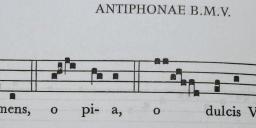Graduale Novum, volume 2
-
Hi,
Unless I missed it, I'm surprised noone noticed the Graduale Novum volume 2 (de frerris et sanctis) has been released.
https://www.conbrio.de/content/buch/kirchenmusik-gregorianik/graduale-novum-de-feriis-et-sanctis
Best Regards, -
I have it on my shelf for some time now, but I need some time to take a detailed look. It's good to see though that they included suggestions for newly added feasts and memorials (like Mary, Mother of the Church and Christ Eternal High Priest).
-
It is an interesting piece of work.
Unfortunately, it comes too late.
Parishes will never use it (not willing to learn new melodies) and musicologists think it contains too many restitution errors. -
I got mine in the mail today along with the 100-page commentary book.
-
Jerome, what musicologists are making that claim?
-
I was interested to see a distropha instead of a tristropha at the beginning of O dulcis in the simple tone Salve. I wonder why they did that?


 O dulcis distropha.jpg1919 x 571 - 125K
O dulcis distropha.jpg1919 x 571 - 125K -
I did notice it was out. What does it have that the Graduale Romanum or Triplex lack? We have volume 1 at the abbey library where I work as a volunteer; I'll have to have a longer look at it. Currently I use the Graduale Triplex.
Ora -
The Antiphonale Monasticum (1934) has only the bistropha.
But the earlier books by Solesmes that I've seen have the tristropha, e.g. the Libri Antiphonarii Complementum pro Laudibus et Horis (1891).
An aside: has anyone ever noticed instances where, in cases of chants that are modern neo-gregorian compositions, editors who come later in time have altered the original of the neo-gregorian piece so that it is more in conformity with their own "more advanced" historical scholarship? -
Most importantly, the restored melodies as published in Beiträge zur Gregorianik. There is more space between the adiastematic neumes and the staff. The Solesmes rhythmic markings are absent. There are occasionally changes in the texts in accordance with the oldest manuscripts (but these are usually written in red in the Triplex as well).What does it have that the Graduale Romanum or Triplex lack?Thanked by 1OraLabora -
@madorganist
I'd guess that it's because of the modern understanding of the strophae as being lightly repercussed, which makes the tristropha a bit much. Whereas if it's a continuous note, it doesn't really make much difference. Especially with the second pair of notes at the unison, two and two repercussed notes in the neume sequence feels better than three and two.Thanked by 1madorganist -
I think two repercussions there is much better than three... but that's just my personal opinion.Thanked by 1Vilyanor
Welcome to the MusicaSacra Forum!
To participate in the discussions on Catholic church music, sign in or register as a forum member, The forum is a project of the Church Music Association of America.
Categories
- All Discussions21,105
- General Music Discussion8,218
- Job Openings197
- Management of Music Programs850
- Choral Matters533
- Church Documents and Rubrics524
- CMAA Notes302
- Events716
- For Newcomers: Read First26
- Sacred Polyphony546
- Hymnody872
- Gregorian Chant: General2,697
- ↳ Graduale Romanum and Liber Usualis368
- ↳ Graduale Simplex60
- ↳ Semiology63
- Vernacular Plainsong696
- Anglican Use and Anglican Chant68
- Organ, Other Instruments and Repertoire435
- New Composition/Works in Progress1,290
- Recordings230
- Music for Hispanic Ministry159
- Music Education: Children211
- Music Education: General222
- News Items245
- Positions Wanted2
- General Discussion: Catholicism739
- Amusements177
- General Discussion1,033
- Opinions117




